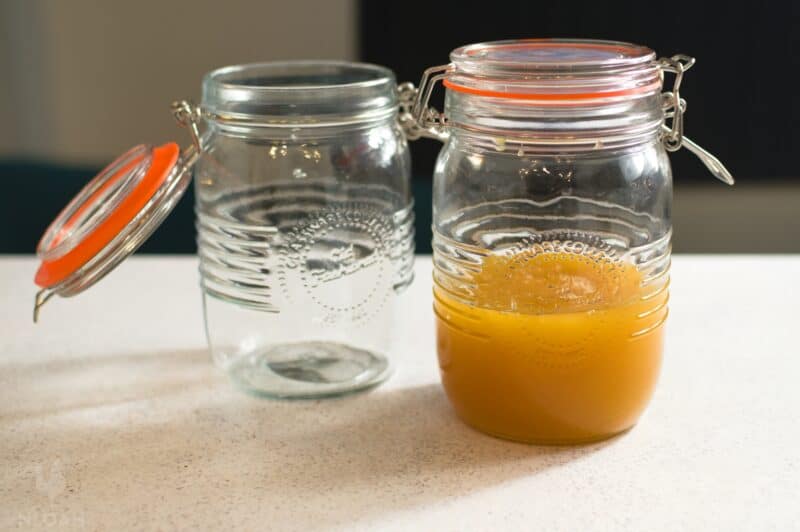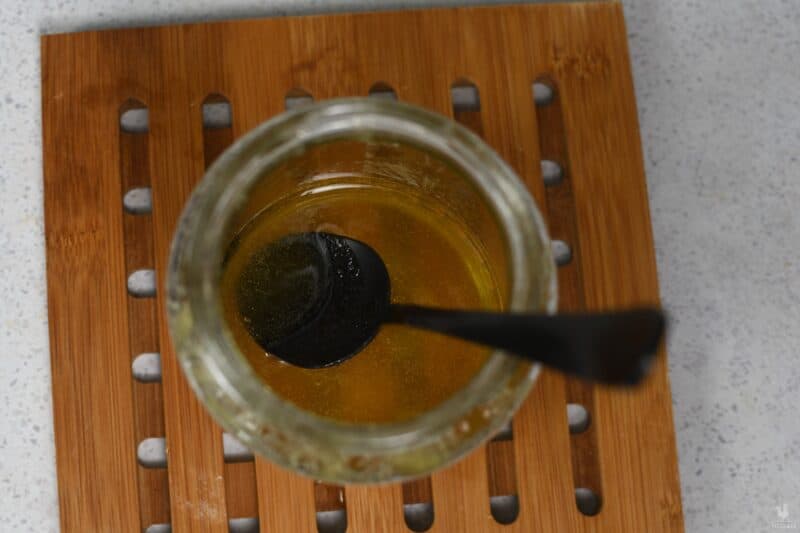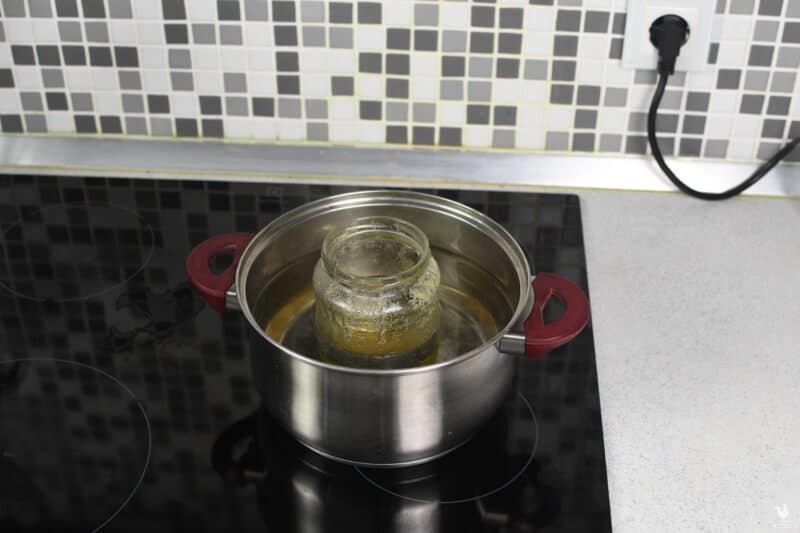Honey is an amazing food. Aside from the fact that bees make it, it can last virtually forever under the right conditions without spoiling. It’s true!

Well-known accounts talk about honey being retrieved from an ancient Egyptian tomb as well as somewhere in the country of Georgia, that was still edible, if crystallized.
So, aside from being wonderful in all sorts of recipes, honey is great to have on hand for the long haul. But if you want to enjoy that incredible shelf life, you’ve got to know how to store it properly. As awesome as it is, it is possible to ruin honey through improper storage, you know!
To help you do that, I’m bringing you a collection of tips and tricks that will help you get the most out of your honey.
Use an Impeccably Clean Glass Container
The first thing you need to know about storing honey properly is that you must, must use a glass container.
Yes, I know that all kinds of honey you buy at the grocery store come in little plastic bottles, including those cheesy bear-shaped ones, but that doesn’t matter.
Plastic is simply too vulnerable to degradation, and this can allow the elements to get to your honey and also directly compromise the honey itself by leaching undesirable chemicals into it.
What you need instead is glass. All kinds of glass containers can work for honey with two prerequisites: first, they must have a tightly sealed lid. Second, they must be impeccably clean.
I know it sounds overblown, but if you want your honey to last as long as possible boil the jar after it comes out of the dishwasher and then thoroughly dry it in an oven set on low heat.
Be sure to check the temp rating of the jar or container, if applicable. That ensures it is as germ-free as possible on the inside. Doing this will completely protect the honey from contamination and significantly slow any degradation that it does experience.
Also, if you purchased honey comes in a plastic container, decant it into a glass one as soon as possible.
Get an Airtight Seal
Protecting your honey from air is absolutely critical to a long shelf life. To do that, the lid for your glass container must be airtight.
Common glass jars and their lids are not airtight once the factory seal is breached, and even something like a mason jar with a brand-new cap and ring might not be airtight unless you’re going through the full canning process.
Disclosure: if you visit an external link in this post and make a purchase, I may earn a commission. Read my full earnings disclosure here.
A better way I have found are those glass food storage jars that have a hinged lid with a built-in gasket and locking lever.
Kept clean and in good repair, these things latch down tight and completely block air from infiltrating the jar and getting to your honey.
They are freely available on the internet from various companies, but not quite as commonly found in department stores.
Also, be wary if you find one at any sort of antique store because the seal is probably degraded. This is my favorite and easiest container for storing honey.
Another option is to use a mason jar with a vacuum-sealing lid and the attachment necessary to pull the air out.
These work like a charm and have the added benefit of eliminating the air inside the container, but the disadvantage is that if you open your jar to get at the honey, you’ve got to go through the process again, otherwise you’re just putting the cap on tightly.
Protect it from Heat
Honey has a fairly forgiving ideal storage temperature of between 50 °F and 70 °F (that’s between 10 °C and 21 °C) but in all cases, you want to protect it from heat. Heat leads to condensation, and condensation means problems for reasons we will learn in a moment.
Worse yet, heat can cause the bonds of honey to break apart, and it will undergo a sort of separation that will seriously impair its quality even if it doesn’t ruin.
This means you shouldn’t store your honey on a countertop where sunlight can hit it or it will be exposed to heat from a stove top or other appliance.
The best place to store your honey is in a temperature-stable pantry in a dark corner where it won’t be exposed to light or heat sources of any kind.
Protect it from Moisture
So air and heat are major enemies of honey, and the third “horseman” of ruin is moisture. If moisture can get to it, it will eventually start the growth of bacteria which will absolutely ruin it.
Lots of folks assert that honey is immune to bacterial growth. It is, in a way, but only when it is first made and kept under the proper conditions.
Honey lasts so long because it doesn’t have enough moisture to support the growth of bacteria, and the high concentration of sugar actually serves to inhibit this growth in kind. The bees know what they are doing, after all, it seems…
But when moisture starts to get to honey, changing the ratio of water and sugar, conditions for bacterial growth will once again exist.
And so the bacteria will begin to grow if even a single organism is present! Accordingly, this is why the right kind of container is so critical, so you can keep moisture out.
But more than that you’ve got to store the honey away from humid conditions. Repeated opening and closing of the container will slowly, surely, let that moisture in over time as will a defective lid or other issue.
Keep it as dry as possible and your honey will go the distance…
Never Use a Wet or Dirty Spoon to Scoop It
Bacteria and moisture are both problematic as we’ve learned, and so you should never commit the cardinal sin with honey of “double-dipping” into the container with a dirty spoon.
This could be the same spoon you used to scoop and eat honey, right out of the container- not that I’ve ever done that- or one you are using to measure and mix other ingredients while cooking or preparing a recipe.
A contaminated spoon will introduce both moisture and germs, and it will greatly accelerate the ruin or outright spoilage of your honey.
Yes, I know it’s delicious. Yes, I know we can get in a hurry. And it’s easy to lose yourself to enthusiasm one way or the other. But keep your wits about you and only ever use a clean spoon when scooping honey!
Don’t Freeze It for Short-Term Storage
Believe it or not, it is possible to freeze honey in order to extend the shelf life dramatically. Not much of a surprise there; most foods can be frozen!
The problem is that freezing honey will significantly impact the quality, though not the safety. When the water content in honey starts to freeze, it typically undergoes separation while it does so.
Even after you defrost and then thaw the honey, it just never tastes the same even though it’s completely safe to eat, no matter how much you stir and mix.
For this reason, do not freeze your honey if you use it regularly, or if you plan to use it for a special recipe in the near-term future.
Consume within 6 to 9 Months for Best Results
Honey can last for an extremely long time under ideal conditions, but the fact of the matter is that a pantry in a busy household, or a working kitchen, is ultimately not the best place for it. No matter how hard you try…
And though your honey might stay unspoiled, it isn’t necessarily going to stay perfectly fresh and in that delicious, liquid gold state. Given enough time, even honey stored with the greatest of care and exacting quality control standards can crystallize.

Now, this can be fixed as we will learn in the next section but it’s better to prevent it from happening entirely. The best way I’ve found to do that is simply to eat or use up the honey before that point.
Depending on the variables involved, you can expect your honey to stay totally perfect for at least 6 months and probably closer to 9 months if you follow all the tips I give you here.
But I know some folks that have reported their honey stays perfect for up to a year following all of these guidelines, or even longer!
For that reason, I recommend you only buy as much honey at a time that you know you’ll use.
Fix Crystallized Honey with Warm Water
For whatever reason, your honey has crystallized: Maybe it wasn’t in an ideal container. Maybe you weren’t so diligent about protecting it from light, heat, or moisture. All you know is that upon taking your honey out of the pantry it is chunky, gritty and grainy. It has crystallized!
Don’t reach for that trash can. Your honey is likely just fine to eat- but you need to decrystallize it. You can do this by immersing the container in warm, not hot, water.

Also, never, ever put the container in rolling boiling water, either! You’ll need to keep the water at a warm temperature, but by giving it anywhere from 30 minutes to a couple of hours, your honey should be back to its original state, though texturally you will still notice it’s a tad bit “off.”
The good news is that if you’re using the honey in a recipe, you shouldn’t notice any difference in flavor or quality. But I notice the difference on my toast, though, and so will you. Oh well, at least it isn’t ruined!
Tom has lived and worked on farms and homesteads from the Carolinas to Kentucky and beyond. He is passionate about helping people prepare for tough times by embracing lifestyles of self-sufficiency.
